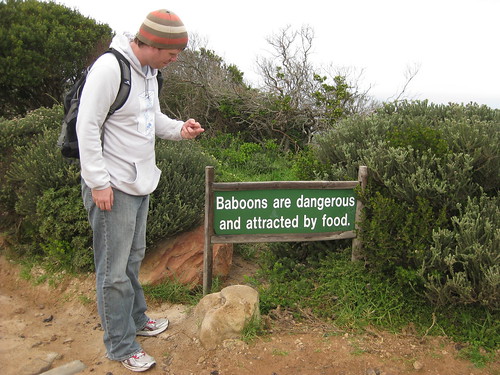 In South African educational parlance, teachers don’t teach “students,” they teach “learners.” I like that.
In South African educational parlance, teachers don’t teach “students,” they teach “learners.” I like that.
If the goal is lifelong learning, then we should start calling ourselves that as early as possible. I’d imagine it’s much easier to think of oneself as a learner in adulthood if you’re used to it from the time you enter school.
A difference exists between “student-centered” education and “learner-centered” education. One seems more all-inclusive, no?
It happened this week. We started Week 1 here in Cape Town with a plan for a week of student-centered workshops. It was to be a beautiful blend of pedagogy’s brightest shining all-stars (Traditional v. Progressive, learning in the Information Age, backward design, etc.) together with the shiniest and most collaborative of tools (digital storytelling, wikis, Google Apps, etc.). It was what was key for the students. In our heads.
But we had to become learners as well. Teaching pedagogy is all well and good in its place. Without a frame of reference for what it means to truly integrate ICT tools, though, the pedagogy doesn’t carry much weight.
We needed to learn what our learners wanted and needed – time to play.
Not unlike too many teachers in the States, teachers here need time to play with the tools at their disposal – tools their schools’ leaders are expecting them to come back ready to use.
We learned to give them what they wanted and what they needed.
The second half of the day Wednesday was dedicated to Word and PowerPoint – inserting pictures, transitions, text wrap, layout, design. Today’s sessions focused on Excel, Smart Boards, experimenting with PowerPoint and searching through flickr.
Yes, I realize pedagogy is important. We must be mindful of why we do what we do with whatever tools we use. Before that, we must experiment, we must be creative, we must fail and learn from that failure.
At the end of the PowerPoint session at the end of the day, our teachers still sat playing with pictures, text, transitions, research from online. They were constructing meaning from something they found interesting and saw held immediate value for their learners.
They were not so enthusiastic about backward design.
At the beginning of the week, Noble said in his welcome to the teachers that our team would be learning as much from the Capetonian teachers as they would be learning from us.
He was correct.
 As promised, I’ve been working on processing the first few days of our time here in CPT.
As promised, I’ve been working on processing the first few days of our time here in CPT.

 Wikipedia
Wikipedia In South African educational parlance, teachers don’t teach “students,” they teach “learners.” I like that.
In South African educational parlance, teachers don’t teach “students,” they teach “learners.” I like that. Something lighter today. It’s 12:15 AM as I write this, and we’re to be leaving for the school at 7:15 AM. My body’s been struggling against a restful night’s sleep for the past two nights, so I’m hoping to wear it down tonight. Clearly, it will have no other choice than at least one complete REM cycle. Yes, this is the plan of a 7 year old. Today was beautiful. As the weather was sunny and the clouds continued to hold back, we took advantage and visited Table Mountain. We took the gondolas rather than making the 4-5 hour hike each way. Next time, I guess. The mountain was tremendous and different than the others I’ve visited in the last 6 months (San Juan, Grand Canyon, Sedona, Blue Mountain). It was pushed up from the sea millions of years ago but remained only an island until the water receded. Most amazing was standing at a precipice and watching the clouds from below fly up the side and overhead. Part of something. On our return trip, we were able to stop by the Pick ‘n’ Pay to purchase the little things. Washing my hair with shampoo tonight rather than lathering with a bar of soap felt indulgent. That was nothing compared to using proper toothpaste to replace the miniscule tube I’d squirreled away from the plane ride. The bulk of the day, however, was spent planning tomorrow’s workshop in detail and scoping out the rest of the week. It was the first time the 6 of us sat in the same room to ply our craft in a focused way. As expected, the dynamic took us a bit to figure out. It was like working as part of a beginning faculty once again. I like that feeling. The biggest challenge for me is holding true to the concept that it’s the ideas, the ways of thinking that can make the most impact here. In the end, if a teacher we work with here isn’t proficient in using PowerPoint, I won’t be worried so long as she has started to see her colleagues in a collaborative life or has begun to let inquiry drive her classroom. With so much to talk about and only a week with this group of educators, I’m reminded of the lure of direct instruction. Fitting the core of ICT tools into a week feels like designing a micro-world history class. If they could just sit in the room, listening rapt with attention as each of us took a turn relaying important information, think how much we could teach. How much would they learn? Tonight, I’m closing with a question. If you were to design a week-long course in ICT, what would be at the top of your list? What would be the first things cut? What would be your biggest focus? All right, I’m closing with three questions.
Something lighter today. It’s 12:15 AM as I write this, and we’re to be leaving for the school at 7:15 AM. My body’s been struggling against a restful night’s sleep for the past two nights, so I’m hoping to wear it down tonight. Clearly, it will have no other choice than at least one complete REM cycle. Yes, this is the plan of a 7 year old. Today was beautiful. As the weather was sunny and the clouds continued to hold back, we took advantage and visited Table Mountain. We took the gondolas rather than making the 4-5 hour hike each way. Next time, I guess. The mountain was tremendous and different than the others I’ve visited in the last 6 months (San Juan, Grand Canyon, Sedona, Blue Mountain). It was pushed up from the sea millions of years ago but remained only an island until the water receded. Most amazing was standing at a precipice and watching the clouds from below fly up the side and overhead. Part of something. On our return trip, we were able to stop by the Pick ‘n’ Pay to purchase the little things. Washing my hair with shampoo tonight rather than lathering with a bar of soap felt indulgent. That was nothing compared to using proper toothpaste to replace the miniscule tube I’d squirreled away from the plane ride. The bulk of the day, however, was spent planning tomorrow’s workshop in detail and scoping out the rest of the week. It was the first time the 6 of us sat in the same room to ply our craft in a focused way. As expected, the dynamic took us a bit to figure out. It was like working as part of a beginning faculty once again. I like that feeling. The biggest challenge for me is holding true to the concept that it’s the ideas, the ways of thinking that can make the most impact here. In the end, if a teacher we work with here isn’t proficient in using PowerPoint, I won’t be worried so long as she has started to see her colleagues in a collaborative life or has begun to let inquiry drive her classroom. With so much to talk about and only a week with this group of educators, I’m reminded of the lure of direct instruction. Fitting the core of ICT tools into a week feels like designing a micro-world history class. If they could just sit in the room, listening rapt with attention as each of us took a turn relaying important information, think how much we could teach. How much would they learn? Tonight, I’m closing with a question. If you were to design a week-long course in ICT, what would be at the top of your list? What would be the first things cut? What would be your biggest focus? All right, I’m closing with three questions.